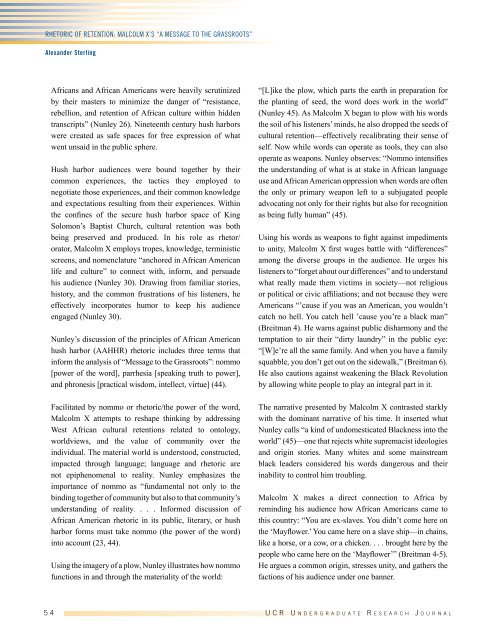Undergraduate Research Journal
Undergraduate Research Journal
Undergraduate Research Journal
You also want an ePaper? Increase the reach of your titles
YUMPU automatically turns print PDFs into web optimized ePapers that Google loves.
Rhetoric of Retention: Malcolm X’s “A Message to the Grassroots”<br />
Alexander Sterling<br />
Africans and African Americans were heavily scrutinized<br />
by their masters to minimize the danger of “resistance,<br />
rebellion, and retention of African culture within hidden<br />
transcripts” (Nunley 26). Nineteenth century hush harbors<br />
were created as safe spaces for free expression of what<br />
went unsaid in the public sphere.<br />
Hush harbor audiences were bound together by their<br />
common experiences, the tactics they employed to<br />
negotiate those experiences, and their common knowledge<br />
and expectations resulting from their experiences. Within<br />
the confines of the secure hush harbor space of King<br />
Solomon’s Baptist Church, cultural retention was both<br />
being preserved and produced. In his role as rhetor/<br />
orator, Malcolm X employs tropes, knowledge, terministic<br />
screens, and nomenclature “anchored in African American<br />
life and culture” to connect with, inform, and persuade<br />
his audience (Nunley 30). Drawing from familiar stories,<br />
history, and the common frustrations of his listeners, he<br />
effectively incorporates humor to keep his audience<br />
engaged (Nunley 30).<br />
Nunley’s discussion of the principles of African American<br />
hush harbor (AAHHR) rhetoric includes three terms that<br />
inform the analysis of “Message to the Grassroots”: nommo<br />
[power of the word], parrhesia [speaking truth to power],<br />
and phronesis [practical wisdom, intellect, virtue] (44).<br />
Facilitated by nommo or rhetoric/the power of the word,<br />
Malcolm X attempts to reshape thinking by addressing<br />
West African cultural retentions related to ontology,<br />
worldviews, and the value of community over the<br />
individual. The material world is understood, constructed,<br />
impacted through language; language and rhetoric are<br />
not epiphenomenal to reality. Nunley emphasizes the<br />
importance of nommo as “fundamental not only to the<br />
binding together of community but also to that community’s<br />
understanding of reality. . . . Informed discussion of<br />
African American rhetoric in its public, literary, or hush<br />
harbor forms must take nommo (the power of the word)<br />
into account (23, 44).<br />
Using the imagery of a plow, Nunley illustrates how nommo<br />
functions in and through the materiality of the world:<br />
“[L]ike the plow, which parts the earth in preparation for<br />
the planting of seed, the word does work in the world”<br />
(Nunley 45). As Malcolm X began to plow with his words<br />
the soil of his listeners’ minds, he also dropped the seeds of<br />
cultural retention—effectively recalibrating their sense of<br />
self. Now while words can operate as tools, they can also<br />
operate as weapons. Nunley observes: “Nommo intensifies<br />
the understanding of what is at stake in African language<br />
use and African American oppression when words are often<br />
the only or primary weapon left to a subjugated people<br />
advocating not only for their rights but also for recognition<br />
as being fully human” (45).<br />
Using his words as weapons to fight against impediments<br />
to unity, Malcolm X first wages battle with “differences”<br />
among the diverse groups in the audience. He urges his<br />
listeners to “forget about our differences” and to understand<br />
what really made them victims in society—not religious<br />
or political or civic affiliations; and not because they were<br />
Americans “’cause if you was an American, you wouldn’t<br />
catch no hell. You catch hell ’cause you’re a black man”<br />
(Breitman 4). He warns against public disharmony and the<br />
temptation to air their “dirty laundry” in the public eye:<br />
“[W]e’re all the same family. And when you have a family<br />
squabble, you don’t get out on the sidewalk,” (Breitman 6).<br />
He also cautions against weakening the Black Revolution<br />
by allowing white people to play an integral part in it.<br />
The narrative presented by Malcolm X contrasted starkly<br />
with the dominant narrative of his time. It inserted what<br />
Nunley calls “a kind of undomesticated Blackness into the<br />
world” (45)—one that rejects white supremacist ideologies<br />
and origin stories. Many whites and some mainstream<br />
black leaders considered his words dangerous and their<br />
inability to control him troubling.<br />
Malcolm X makes a direct connection to Africa by<br />
reminding his audience how African Americans came to<br />
this country: “You are ex-slaves. You didn’t come here on<br />
the ‘Mayflower.’ You came here on a slave ship—in chains,<br />
like a horse, or a cow, or a chicken. . . . brought here by the<br />
people who came here on the ‘Mayflower’” (Breitman 4-5).<br />
He argues a common origin, stresses unity, and gathers the<br />
factions of his audience under one banner.<br />
5 4 U C R U n d e r g r a d u a t e R e s e a r c h J o u r n a l














